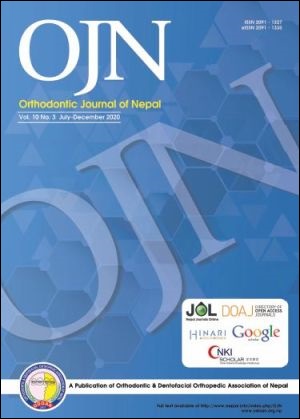Comparison of Accuracy of Gonial Angle of Orthopantomogram and Lateral Cephalogram for Mandibular Measurements among Orthodontic Patients Attending Tertiary Care Dental Hospital in Kathmandu
DOI:
https://doi.org/10.3126/ojn.v10i3.35497Keywords:
Gonial angle, Lateral cephalometric radiograph, OrthopantamogramAbstract
Introduction: Gonial angle is an important parameter of the craniofacial complex which is generally used to evaluate the vertical parameters and symmetry of the facial skeleton. Gonial angle can be measured in both orthopantomogram (OPG) and lateral cephalograms. Due to the superimpositions seen while measuring the bilateral strucuture on lateral cephalograms, reliable measurement of the gonial angle becomes difficult. This study is done to clarify the possible application of orthopantomogram (OPG) for evaluating angular measurement of the mandible specifically gonial angle by comparing with lateral cephalogram.
Materials and Method: All the patients (104) being treated from January 2018 to August 2020 in department of Orthodontics in Nepal Medical College were included in the study. Gonial angle measurements were made on lateral cephalograms and orthopantomograms of 104 patients – 54 males and 50 females with mean age of 22.20 ± 3.25 years. Patients aged 15-35 years were included in the study. Data was processed in SPSS version 16.0.
Result: Mean Gonial angle in lateral cephalogram was greater than mean gonial angle in OPG and this difference was found to be statistically significant (p-value < 0.05). The difference in mean gonial angle was found to be statistically significant when compared between right gonial angle in OPG and gonial angle in lateral cephalogram (p-value < 0.05) and also between left gonial angle in OPG and gonial angle in lateral cephalogram (p-value < 0.05).
Conclusion: When gonial angle values obtained from both sides of OPG were compared, no statistically significant difference was found. Significant differences were found when gonial angle values obtained from OPG right and left sides were compared with that of lateral cephalogram.
Downloads
Downloads
Published
How to Cite
Issue
Section
License
Copyright © held by Orthodontic & Dentofacial Orthopedic Association of Nepal
- Copyright on any research article is transferred in full to the Orthodontic & Dentofacial Orthopedic Association of Nepal upon publication in the journal. The copyright transfer includes the right to reproduce and distribute the article in any form of reproduction (printing, electronic media or any other form).
- Articles in the Orthodontic Journal of Nepal are Open Access articles published under the Creative Commons CC BY License (https://creativecommons.org/licenses/by/4.0/)
- This license permits use, distribution and reproduction in any medium, provided the original work is properly cited.




